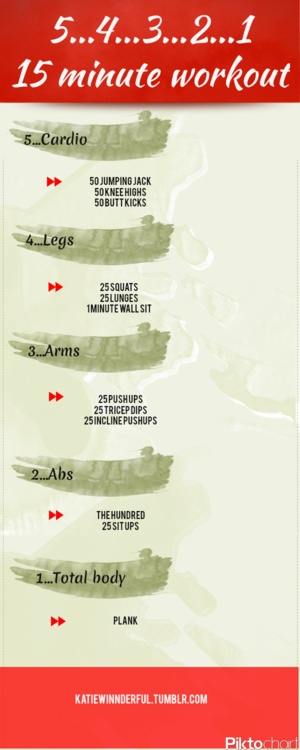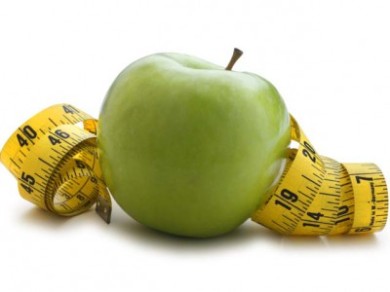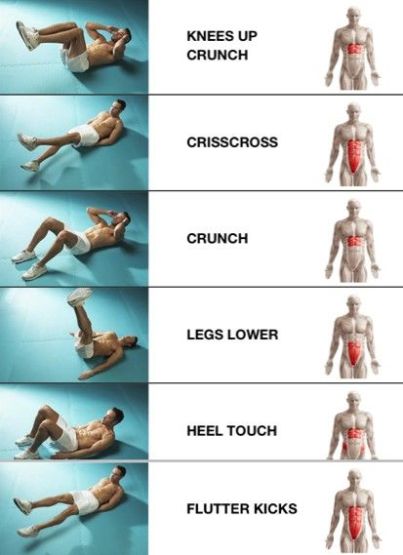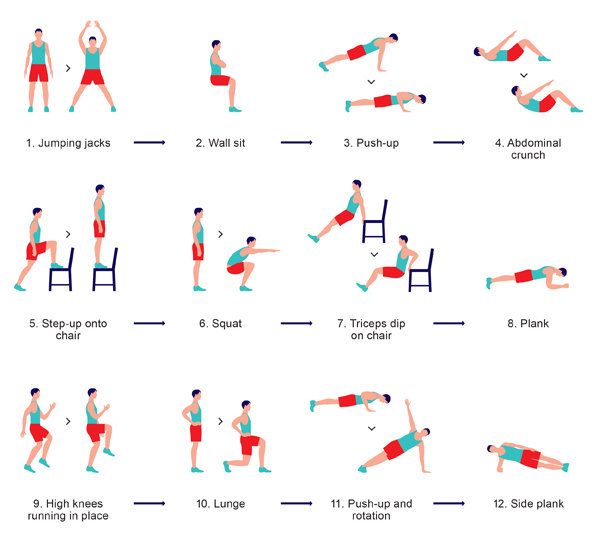
The first step is the hardest. This saying is especially true when applied to fitness. Bodies in motion tend to stay in motion, and bodies at rest tend to stay at rest. But the good news is this: Once you get moving, you’ll stay moving! The first thing to do when getting started with fitness is determining where you are. Consider the five starting points, described below, in terms of your level of activity in the last 12-18 months.
What’s Your Starting Point?
From least intensity to most intensity:
RPR: Rehab/Post Rehab. You have suffered some type of injury, trauma or breakdown of body tissues that may or may not have required surgery. While the underlying problem MAY have resolved, there has been no real effort made to bring the tissues (or the body as a whole) back to any level of strength. Your daily activities and life are affected and compromised by this problem.
ADL: Activities of Daily Living. You are healthy and live a normal life, but you haven’t done any dedicated exercise in the past 12-18 months.
GF: General Fitness. You have done some specific, dedicated exercise in the past 12-18 months. It might not have been anything like seen on weight-loss reality shows, but it was specific and dedicated.
SPG: Specific Physical Goals. You have gone beyond a typical exercise routine. At some point in the last 18 months, you’ve also dedicated yourself to weight loss or fat loss or some other physical goal, such as running or riding a bike for a certain distance or lifting a particular amount of weight.
AA: Athletic Achievement. You have trained to compete in some athletic endeavor in the past 12-18 months.
Here’s the twist: Now that you have figured out where you’re at, you’ll start at the level just below. That way you can bring your body back to the level you were at when you were at your peak in the past 12-18 months. This might seem like a step back, but it’s not: Starting a little easier than you think is appropriate will never hurt you, and you can progress quickly. And if you’ve misjudged a little, at least you’ve erred on the side of safety. You have plenty of time!
By way of example, here are some ideas on places to start and where I would rank them.
Walking. People in the GF or ADL categories should start here. It might seem a little slow, but walking is good for you. If you want to figure out why the human body is built the way it is, get up and walk—you will have your answer. People in the RPR category may want to get cleared by their doctor first, depending on their condition.
Home activities. Cleaning the house, walking the dog, home repairs, landscaping, gardening and the like are all ways get active. They are especially good for people starting in the GF, SPG or ADL categories. Even the RPR folks have to take care of the house. Studies show this kind of activity makes a marked difference in one’s health!
Recreational activities. Jogging, cycling, soccer, softball, golf and the like are all good activities that you can do in small groups or by yourself. These are appropriate for GF, SPG, and AA folks. People in the RPR and ADL categories might find these activities too intense to do for long periods of time.
Specific interest activities. Yoga, Pilates, martial arts, kickboxing, ballet, hip-hop dance, rock climbing—the list goes on. Some of these are appropriate far all levels, even the RPR folks (yoga, pilates), while others, like rock climbing or martial arts, may be for the SPG and AA folks only.
Gym activities. I put this in a separate category simply to illustrate how many other ways there are to start exercising without hitting the gym. The gym has something to offer people at any fitness level, but it is not for everyone. It’s a great place to start, but not the only place!
S.M.A.R.T. Goals
Now that you’ve figured out where you are fitness-wise, and where you might start, let’s figure out where you are going. That means setting some goals. Here is the S.M.A.R.T. goal system I learned from Peter and Lorna Francis, and I think it will help you.
S – Specific goals. The more specific your goals, the easier it is to reach them. “I want to get in shape” is a general goal. “I want a smaller waist, thinner thighs, and a stronger upper body” are specific goals. The more specific the goal, the less likely you are to let yourself off the hook when it comes to reaching them.
M – Measurable goals. Your goals must be measurable. Think of the difference between saying “I want to lose weight” versus “I want to lose 20 pounds.” With a measurable goal, there is a number to measure success. As “The World’s Greatest Strength Coach” says: that which is measured IMPROVES.
A – Action-oriented goals. Your goals must call you to action. For example, saying you want to eat right IS NOT an action goal. Saying you will eat breakfast every day and eat 6 servings of fruit and vegetables every day IS an action goal.
R – Realistic goals. If you have gained 50 pounds in the last year, setting a goal of losing it in 3 months is not realistic. This may be the most important aspect of goal setting, because unrealistic goals set you up for failure. Failure leads to apathy, resignation and acceptance of your current state as all there is. Be real with yourself.
T – Timetable Goals. Set a realistic, concrete timeline for your goals. “Someday” is not on any calendar I have ever seen.
Get F.I.T.T.R, Stay F.I.T.T.R.!
The great Dr. Kenneth Cooper says fitness retained is easier that fitness regained. Great words of wisdom. Let me go one step further is explaining how fitness is attained. Here is a basic primer using the time-tested F.I.T.T.R principle.
Frequency. This is how often you apply a specific “stress” to the body. Yes, exercise is controlled, dedicated and specific stress to the body for the purpose of causing the body to adapt and change. Frequency is usually measured in the number of times per week. More frequency is correlated with greater and faster results, but only to a point. More IS NOT better beyond a certain level.
Intensity. Intensity is not how “intense” or “hard” a workout is. Intensity refers to the amount of work done compared to the amount of work possible. For cardiovascular training, it is usually measured in a percentage of your maximum heart rate. For strength training, it is usually measured in a percentage of your one repetition maximum resistance for a particular exercise.
Time. How much time did you spend jogging? How much time did you spend lifting weights? (Technically, it is time under tension that counts, which, like time jogging, is also known as volume. Standing around shooting the breeze with your friends IS NOT time under tension.)
Type. For the beginner, this is a simple concept. Cardio or weights? The first is aerobic in nature, while the second is anaerobic. That is what allows some people to do both on the same day.
Rest. How much time between sessions do I need for my body to recover and improve? Remember this: you don’t improve during a workout, you improve when you rest between workouts. No rest? No improvement!
These principles relate to each other. The more intense a workout, the less time it should take, the less frequent it should be and the more rest it is recommended. (And vice-versa.) The type is also a relating factor. Cardio can be done more frequently that weight training (usually) but you need rest from both. Depending on your goals, high intensity workouts may not ever be necessary for you. In the end, you have to have goals and listen to your body.
Now, go back and review your goals in light of this info. I’m guessing they have changed a little. When in doubt, err on the side of less. Remember, if you start out with too much F.I.T. you may get hurt, and then you are nowhere. But if the workouts are too easy, you can always advance quickly.
5 Tips to Get You There
Here are 5 tips that will increase your chances for success.
1. Learn the difference between pain and injury. Any exercise that produces results will involve discomfort and sore muscles. Remember what I said about exercise being stress? As time goes by you will learn that pain can and should be momentary. And if you follow some of the rules I have outlined above, you will reduce your risk of injury significantly.
2. Train smarter, not harder. You don’t always have to train to the point of pain and exhaustion, depending upon your goals. Even the most advanced exerciser has to pick and choose when to go hard and when to back off. Sometimes it’s best to train at the same intensity, just do less time.
3. The 1% solution: In order to make progress, your body must be forced to adapt. One way to ensure continued adaptation is the 1% solution. It’s simple—try to do 1% more each time you exercise. If you exercise 3-4 times a week, you can see how that will add up over a year or two.
4. No TRAIN, no GAIN. Exercise is not like money—you can’t exercise really hard for a couple of years and live off of it for the next three. After about 100 hours of inactivity, your level of fitness starts to decrease.
5. Partner up. Finding a partner to train with is one of the best ways to stick with it. If your partner is counting on you, it’s more likely you will not let them—or yourself—down. And, it’s just more fun when someone else is there to motivate you!
Whatever exercise you choose, choose to start today—and good luck!





